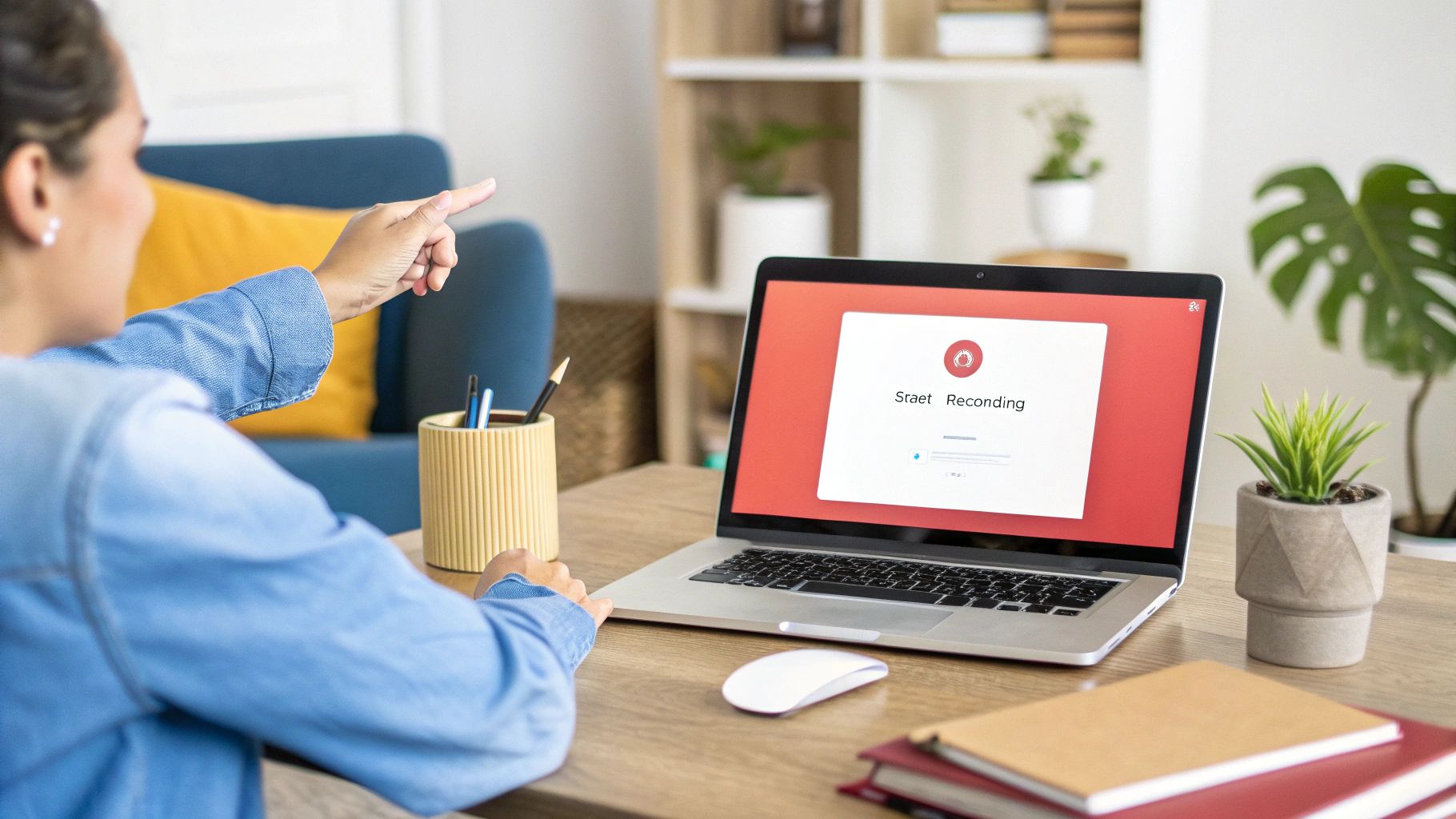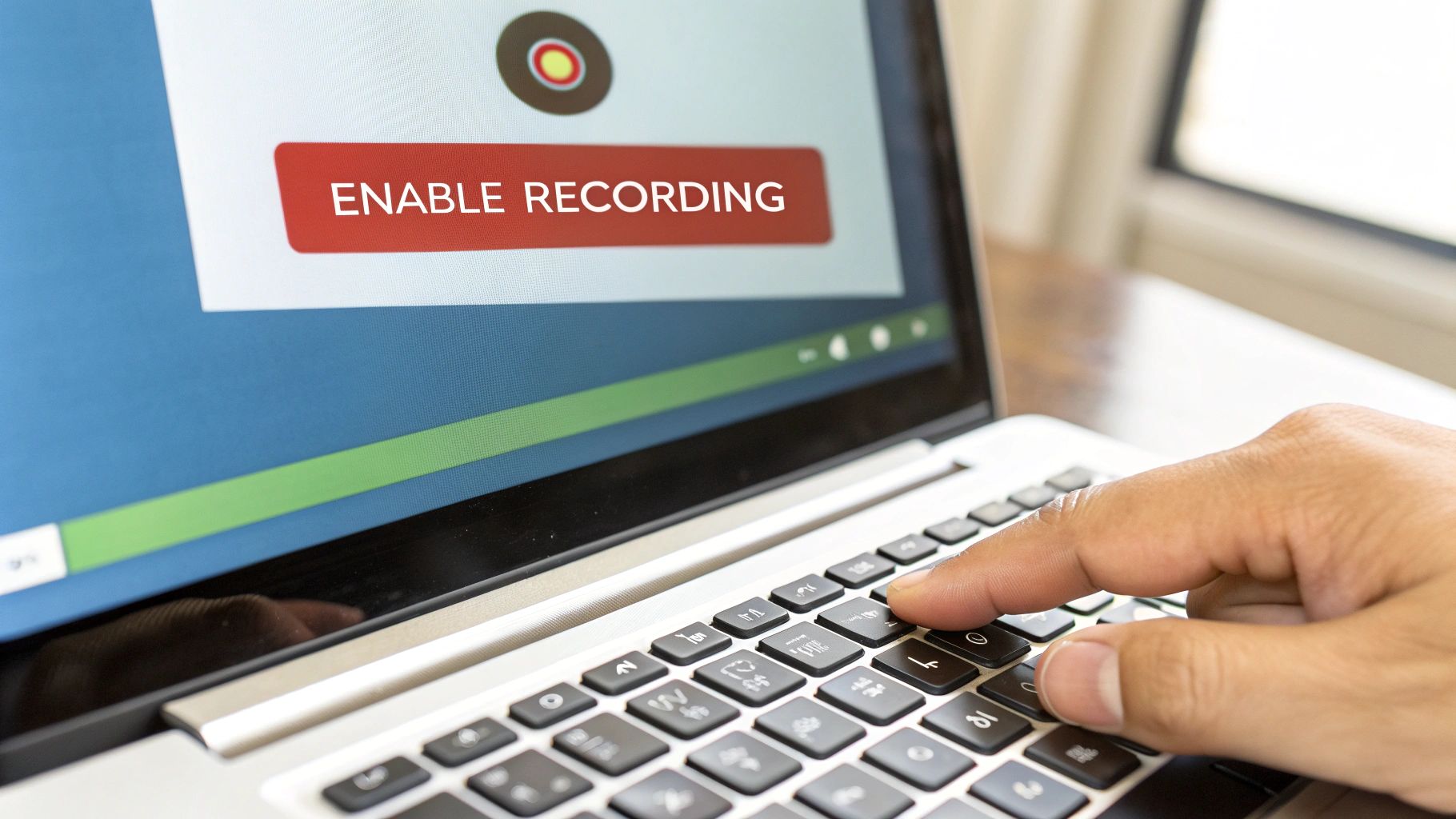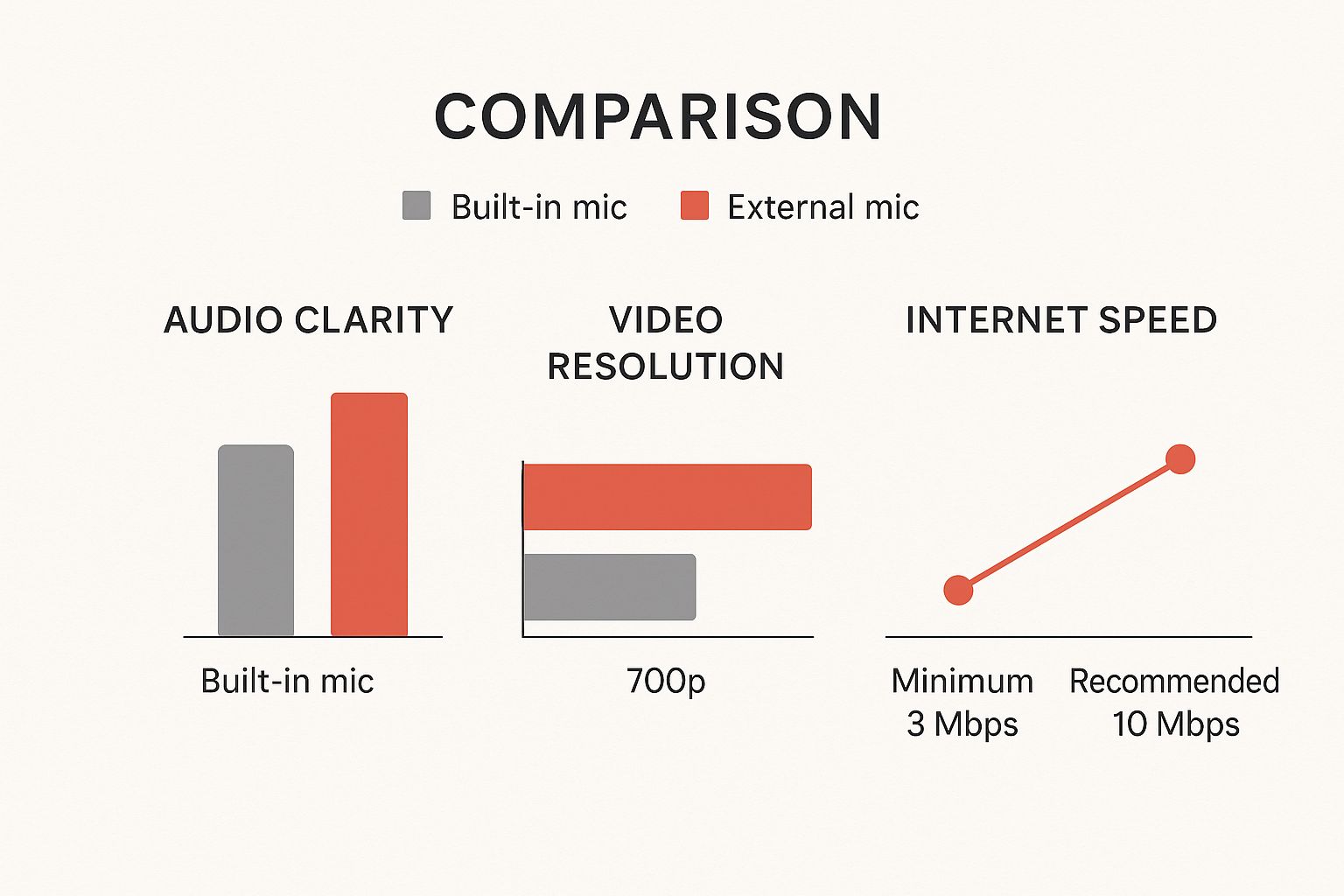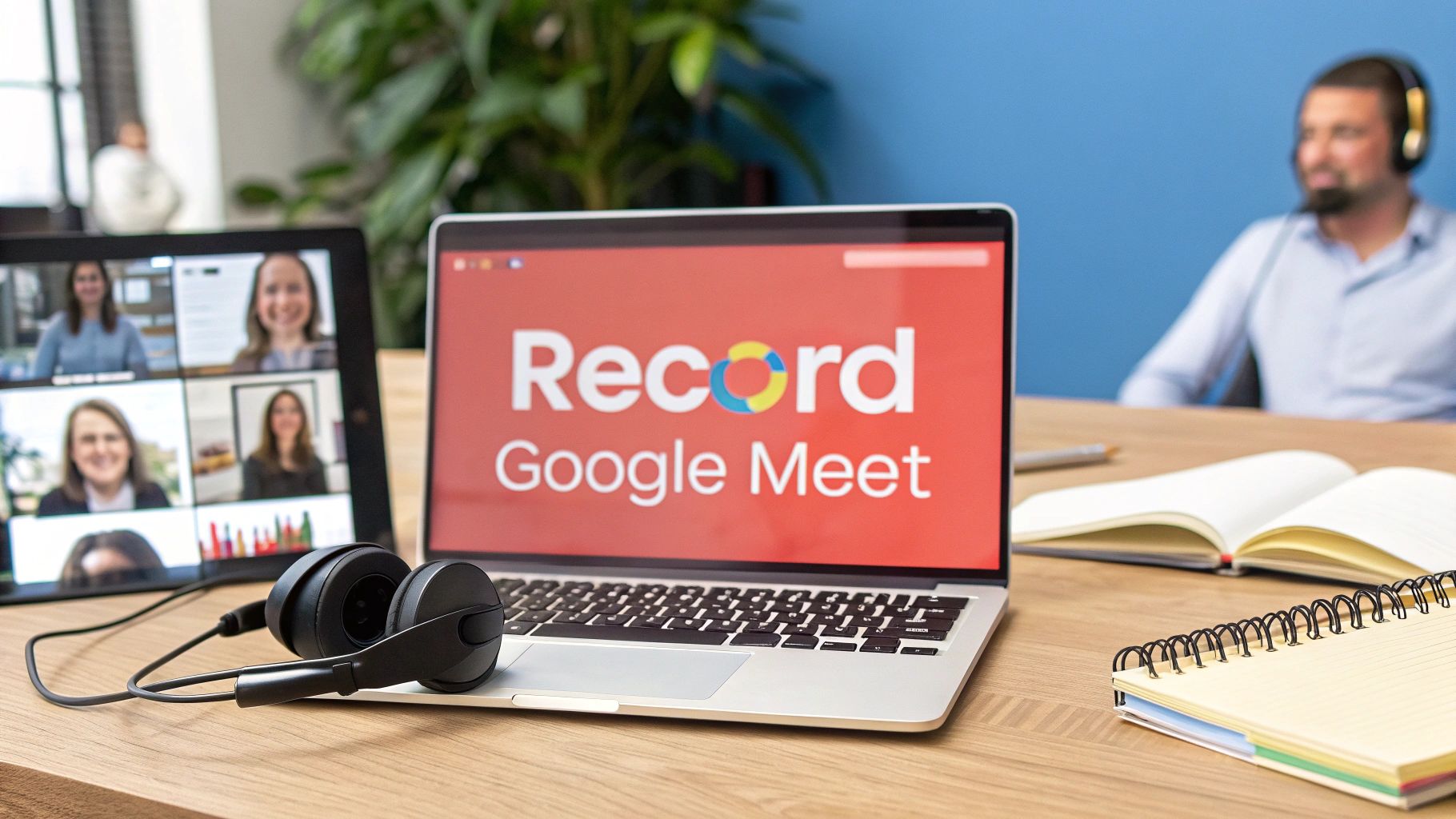For a modern agency, knowing how to record a Google Meet isn't just a nice-to-have technical skill. It's fundamental. This one practice can be the difference between relying on foggy memories for crucial client feedback and having a permanent, verifiable record of every single project-defining conversation.
Why Your Agency Must Master Recording Google Meet Calls

In the chaos of agency life, client meetings are the bedrock of every project. It's where strategies are born, feedback is handed down, and approvals are (hopefully) secured. Just showing up to these calls isn't enough anymore. You need to capture every detail to protect your team and deliver killer results.
Think of it this way: a recorded meeting becomes the single source of truth. It completely wipes out any "he said, she said" arguments and serves as undeniable proof of what was actually agreed upon. This simple act protects your agency from the dreaded scope creep that can absolutely destroy budgets and timelines.
Beyond Note-Taking: A Strategic Asset for Agencies
The real magic happens when you stop seeing recordings as just a backup. For agencies, these recordings are multi-faceted assets that genuinely strengthen both your operations and your client relationships.
Getting the hang of recording a Google Meet unlocks some immediate, powerful benefits:
- Ironclad Project Scopes: You can pull timestamped clips to confirm specific client requests or feature approvals. There's just no room for misinterpretation.
- Powerful Training Material: Onboard new account managers in record time by having them review past client kickoff calls and tough strategic discussions.
- Enhanced Team Alignment: When a key designer or developer misses a call, they can watch the recording to get fully up to speed without relying on secondhand info. It's a massive win for keeping project momentum going.
This is especially critical when you consider Google Meet's massive footprint. With over 300 million monthly active users, it's a platform your clients are already comfortable with and using daily.
A meeting recording is your agency's best defense against misunderstandings. It transforms subjective memory into objective fact, ensuring everyone—your team and your client—is aligned on deliverables and expectations.
Now, before we jump into the "how-to," there's a catch you need to know about. Google Meet's built-in recording feature isn't available to everyone. Access depends entirely on which Google Workspace subscription you have. Understanding this limitation is the first step to building a reliable recording process, which might mean exploring some powerful alternatives.
For more on this, check out our guide on client communication best practices.
How Agencies Can Use Google Meet's Built-In Recording Feature

For many agencies, Google Meet's native recording tool is the path of least resistance. It’s built right in, so you don't have to fuss with extra software, and it plays nicely with the Google ecosystem your team already lives in. That convenience factor is a big reason Meet has held its ground for so long.
But here’s the catch: that little "Record" button isn't a universal feature. Access is one of the key ways Google differentiates its subscription plans. To record a Google Meet call natively, your agency needs to be on a qualifying Google Workspace plan.
Step 1: Confirm Your Agency’s Google Workspace Access
Before you bank on this feature for a critical client kickoff, you need to double-check your subscription level. The built-in recording is typically included in these common business-focused plans:
- Business Standard
- Business Plus
- Enterprise Essentials, Standard, and Plus
- Certain Education and Non-profit editions
If your agency is running on a Business Starter plan or using free, personal Google accounts, the record option simply won't be there. Upgrading your plan is the only way to unlock this functionality directly through Google. It's a classic example of how they segment features for different organizational needs.
Step 2: Streamline Your Agency’s In-Meeting Recording Workflow
Once you've confirmed you have access, actually starting a recording during a client call is dead simple. As the meeting organizer (or someone in the same organization), you can kick it off from the "Activities" menu. When you do, every single person in the meeting gets a clear notification that it's being recorded—a crucial step for transparency and consent.
The real magic for an agency happens after the call ends. Once stopped, the recording is automatically processed and saved to a special "Meet Recordings" folder in the organizer's Google Drive. This completely sidesteps the headache of manually uploading and organizing huge video files.
From there, the file is automatically shared with everyone on the meeting invite, making internal distribution a breeze. If you need to share it with a client, you just adjust the Google Drive permissions for their email address. It gives you total control over who can view or download the recording.
This entire workflow was born out of the shift to remote work, and its continued relevance is clear when you see stats like Google Meet's 6.23 million downloads in July 2024 alone. You can find more interesting stats on conferencing tools over at electroiq.com.
Unlocking Advanced Google Meet Recording for Agencies with Third-Party Tools
While Google's built-in recording is a decent starting point, it's really just the opening act. For an agency juggling multiple clients, projects, and tight deadlines, a simple video file just doesn't cut it. You need tools that turn those long conversations into actionable intelligence—and that’s exactly where third-party solutions come into play.
These tools plug right into Google Meet but go way beyond basic video capture. Instead of just handing you a file to re-watch, they use AI to create genuinely useful assets like full transcripts, automated summaries, and crystal-clear action items. For a busy agency, that’s a total game-changer.
How Your Agency Turns Conversations Into Searchable Data
Picture this: you're trying to find a specific client request buried somewhere in a 60-minute video call. It’s a massive time-sink. Tools like Scribbl completely eliminate this headache by giving you a word-for-word transcript that's instantly searchable.
This means your project manager can find the exact moment a client approved a design change in seconds. Or a developer can pinpoint a technical requirement without having to scrub through an hour of video. It’s all about converting spoken words into structured, usable data that saves you billable hours. This is especially vital when you consider Google Meet's massive scale, with a user base now exceeding 300 million monthly users.
The quality of these recordings matters, too. Small technical factors can have a big impact on the final output.

As you can see, even small upgrades in your team's equipment and internet speed can dramatically improve the final recording, ensuring everything is crystal clear for your team and your clients.
How Agencies Leverage AI-Powered Insights
The real magic of these advanced tools is their ability to actually analyze the conversation. They don't just record a Google Meet; they interpret it.
Here are a few features that directly solve common agency pain points:
- Automatic Summaries: Get a high-level overview of the meeting’s key points delivered straight to your inbox. This is perfect for stakeholders who don’t have time to watch the full recording but still need to be in the loop.
- Action Item Detection: The AI automatically flags tasks and assignments as they come up in the conversation, making sure no deliverable ever falls through the cracks.
- Speaker Identification: Transcripts clearly label who said what. This eliminates any confusion and holds everyone accountable for their contributions and approvals.
By automating note-taking and task assignment, these tools free up your team to focus on what they do best—strategy and client relationships, not tedious admin work. They turn every client interaction into an opportunity for better accuracy and efficiency.
Google Meet Native Recording vs. Third-Party Tools: An Agency Comparison
While Google Meet's recorder is fine for basic record-keeping, it's clear that agencies needing to extract real value from their meetings will benefit immensely from the advanced capabilities of a third-party tool.
Of course, choosing the right tool is key to getting the best return on your investment. To help you navigate the options, we've put together a guide on the best app for recording meetings that dives deeper into the top contenders.
How Agencies Should Record Client Meetings Legally and Ethically

Hitting "record" on a client call is a powerful move, but it comes with a heavy dose of responsibility. For agencies, navigating the legal and ethical side of this isn't just a suggestion; it’s a cornerstone of building and keeping client trust. One misstep here can quickly unravel a relationship you’ve worked hard to build.
The absolute golden rule? Obtaining explicit consent before you record any Google Meet call. Nothing sours the start of a meeting faster than surprising a client with a recording notification. It’s unprofessional and creates immediate friction.
Step-by-Step: How Agencies Should Get Consent
The best approach is to make this a standard, non-negotiable part of your agency's process. It’s all about transparency and framing the recording as a tool that helps everyone involved.
Just kick off every client call with a clear, friendly announcement. Your team can adapt simple scripts like these:
- For project accuracy: "Hey everyone, just a quick heads-up, I'm going to start the recording so we can capture all the details accurately for the project brief. Is everyone okay with that?"
- For shared reference: "Before we dive in, I'd like to record this session so we all have a copy to refer back to. I'll share the link with you afterward. Sound good?"
This small step positions the recording as a collaborative asset, not some kind of sneaky surveillance.
Transparency is non-negotiable. Always state your intent to record and get verbal confirmation before proceeding. This simple step protects your agency and reinforces to the client that you operate with integrity.
Ensuring Compliance: Consent Laws and Data Security for Agencies
It's also crucial to have a basic grasp of the legal framework, which can change depending on where your client is located. Some places operate under "one-party consent," meaning only one person on the call needs to know it's being recorded. Many others, however, require "two-party consent" (or all-party), which means everyone has to agree.
To stay compliant and dodge any legal headaches, your agency's policy should be simple: always act as if you're in a two-party consent jurisdiction. That means you always get everyone's permission, every single time.
Finally, you have to think about data security. Client conversations are confidential. Make sure you store any recordings securely in a designated, access-controlled folder in your agency's Google Drive. Limit access strictly to the project team members who need it. Treating these files with the same level of care as any other sensitive client data is absolutely essential for maintaining long-term trust.
Turning Your Agency's Recordings Into Actionable Assets
Let's be real—a raw video file sitting untouched in a Google Drive folder isn't doing your agency any favors. It's a wasted opportunity. For any busy team, the real magic happens when you turn that long-winded discussion into tangible assets that actually speed up projects and make everyone's lives easier. This all comes down to having a solid post-meeting game plan.
First things first: get that conversation transcribed. Using an AI tool to convert the spoken words into searchable text is a simple move that completely changes the game. Suddenly, that unstructured video becomes a powerful, queryable document. Your project manager can ditch the tedious task of scrubbing through an hour-long call and instead find a key decision or specific client request with a quick search.
From there, you can easily pinpoint and timestamp the moments that truly matter.
How Agencies Can Repurpose Recording Content for Growth
Once you have a transcript, a single meeting recording can be sliced and diced in a bunch of ways to support different parts of your agency.
- Build Bulletproof Project Briefs: Pull exact client quotes and approved specs directly from the transcript. This helps you create project briefs that leave absolutely no room for misunderstanding or ambiguity.
- Create a Client Knowledge Base: Start tracking your client's preferences, feedback patterns, and big-picture goals mentioned across different meetings. Over time, this builds an incredibly rich internal resource for your team.
- Snag Some Killer Case Study Snippets: With your client's permission, of course, you can extract powerful testimonials or problem-solving moments to sprinkle into your marketing materials.
A disciplined approach to managing your meeting recordings is like a secret weapon for your agency. It cuts down on miscommunication, prevents scope creep, and makes sure every project is built on a solid foundation of shared understanding.
For agencies that really want to squeeze every drop of value from these conversations, feeding these insights into a broader Business Intelligence Strategy can unlock a whole new level of success. You can also learn more about effective action item tracking to see how you can dial in this process even further.
Common Agency Questions About Recording Google Meet Calls
When it comes to the nitty-gritty of recording Google Meet calls, a few questions always seem to pop up for agency teams. Getting these answers sorted out ahead of time means you can focus on the client, not the tech.
Can My Agency Record If I'm Not the Host?
This is a big one. Natively, Google Meet doesn't let you hit record unless you're the meeting host or have been given co-host powers. It's a built-in permission thing.
But what if you still need to capture the conversation? You can use a third-party screen recording tool. However, and this is critical, you must get explicit consent from every single person in the meeting before you start. This isn't just about being polite—it's about complying with privacy laws and, frankly, maintaining the trust you've built with your clients.
How Long Are Agency Google Meet Recordings Stored?
When you use the built-in recorder, the video file automatically lands in a special "Meet Recordings" folder in the host's Google Drive.
The good news? These recordings stick around indefinitely unless someone actively deletes them. The not-so-good news? That can lead to a messy Drive and potential data risks. Your agency really should have a clear policy for how long you keep these files, especially when they contain sensitive client info.
Best Practices for Agencies to Share Recordings with Clients
Security should be top of mind here. The safest and most professional way to share is directly through Google Drive. Just share the file with your client's specific email address and set their permission to "Viewer."
That simple "Viewer" setting is key—it stops them from downloading the file or sharing it with others without your go-ahead. Whatever you do, avoid sending the raw video file as an email attachment or using those "anyone with the link" public URLs. You lose all control over who sees it, which is a risk no agency should take.
Stop wasting hours re-watching meetings and manually taking notes. Scribbl automatically transcribes, summarizes, and identifies action items from your Google Meet calls, saving your agency team over 5 hours a week. Get started and transform your meeting workflow today at https://www.scribbl.co.




